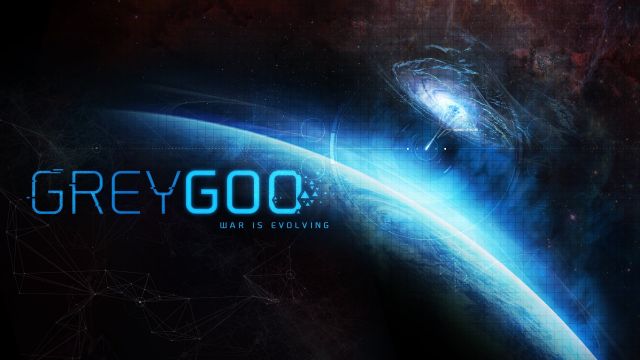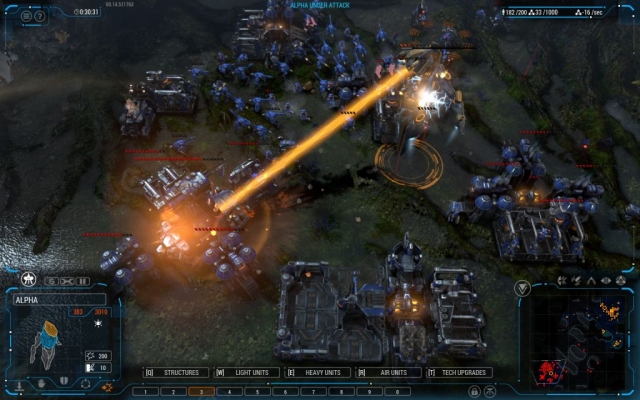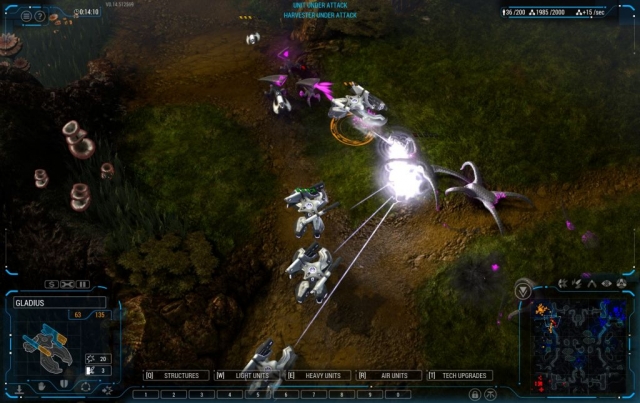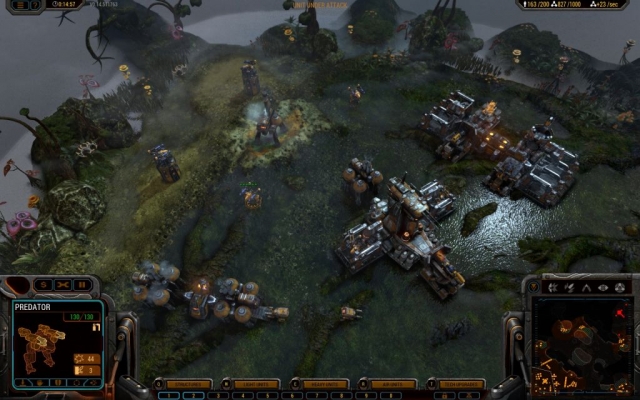Grey Goo

The Good: Not exactly new RTS gaming elements, but a really nice mix and presentation of many older ones. AAA-grade cutscenes and voice work. Multiplayer supports LAN!
The Bad: Balance, economy and AI issues. Short single player campaign is like an extended tutorial. Limited multiplayer maps.
The Ugly: Nothing.
I realize the market is pretty well loaded up with RTS games depending on how wide you’re willing to cast the RTS net. Company of Heroes, Warhammer 40k, Starcraft (the 900 pound gorilla in the room) and a huge number of indy titles. But, and here I’m entirely speaking for me personally, I really miss Command and Conquer. Not the crazed obscenity against nature that was C&C4, but the earlier titles. I most particularly hold a fondness for Generals and Zero Hour, but even today, for reasons that are hard to describe, I still play Kane’s Wrath more than Starcraft II or any of its variants. So I for one did a little endzone shuffle upon hearing that some of the old Westwood crowd was interested in making another RTS game. Grey Goo (admittedly not a rousing title) is the culmination of that effort, and while not perfect, it is a really, really good start.
The framework of GG will be instantly familiar to anyone who plays RTS games. GG brings with it the now sort of standard 3 races to play: the humans, the Beta, and the titular Grey Goo. There is only a single resource to collect and it resides in depletable geysers around the map, which the player sets refineries upon. There are light and heavy combat units covering the land and air (there is no sea). See, familiar? Beyond that simple framework, they’ve done some really interesting things.
The humans and Betas both have small “soldier” units, as well as light and heavy vehicles. They both have artillery, fighters, and bombers. Human bases require power lines to be run between all the buildings and defensive turrets, and those power lines are vulnerable to attack. The Beta in contrast can build anything anywhere they can get away with it (like C&C Generals) and don’t need their bases and outposts to be connected. The Betas furthermore don’t build defensive turrets. They do build wall segments and can place units upon the walls to create things that look and act like turrets however. The astute reader will notice that I haven’t really described the Grey Goo yet, and that’s with good reason – they are far and away the most “alien” species. People who try and draw connections between the Goo and the Zerg simply because they are both alien are on a fool’s errand. Goo, at least to my knowledge, is unlike any other RTS species ever created. They build no buildings – none. There is a unit called the mother goo, which is the basis of everything – kind of factory, refinery, and combat unit all rolled into one. It squats its fat ass down on resource geysers to gather, and births out smaller units (or duplicates of itself) which in turn subdivide into combat units. Subsequently the goo doesn’t have a build queue – you click on a unit and select what you want it to subdivide into, and then that original unit is gone. Raising a small army of goo units is really easy, and I think faster and cheaper than other species can do it, but building a large force is a clickfest unlike any I’ve seen. Oh, and goo have no air units. I guess goo isn’t very aerodynamic.
The single player campaign spans 15 missions, 5 played as each race. The early missions for each species have crippled build trees, offering limited units, buildings and research options and are little more than an extended tutorial. For those who play RTS games regularly, these are unnecessary tutorials. Though filled with first-rate cutscenes and excellent voice work and a pretty good plot, from a gameplay perspective the campaign is disappointing.
The game seems to suffer from some serious balance issues, most significantly in the overall economy. A refinery generates extract or catalyst or Vespene or whatever they call it at a rate of 10/second or so. Initially, your storage capacity is 1000 (you can increase that by building silos) and you typically start a level with a full tank. A refinery costs 800 and a small factory costs 200, so immediately all that cash is spent, and it takes 100 seconds to get that back. For the first two or three minutes of every game, you’re doing nothing more than building a refinery and a factory. It’s a really slow start to a game that overall has a very slow roll to it. And I don’t mean slow like in Company of Heroes, where it takes a long time to build a tank, but they’re a really significant fighting unit and the game is almost about building a few units and using them really effectively. Units in GG are expensive, but weak. It takes about a minute to build a tank, so you can spend half an hour building up a force of any significant size. Base defenses, for Beta or humans, are pretty tough, and you can take that brand spanking new force of yours and smash it against your enemy’s walls without much to show for it. Or you can try to build up really expensive but fragile artillery units and try and destroy your enemies defenses that way, but the enemy can, with just a few tanks, wipe them out. There will probably be people who are good at GG, mostly rushers I suspect, but I found the process of slowly building up a big force to be frustratingly slow. Research technologies likewise are all over the map in terms of cost/benefit. One, for example, allows tank units to autorepair out of combat, but they are destroyed so quickly they rarely survive to autorepair, and the autorepair is so slow as to be nearly useless. Air units like bombers cost a fortune, are shot down easily by anti-air units, and don’t carry much for ammunition and so have to keep returning to the home base for re-supply. I’d be curious to see statistics for who builds what units, because I suspect many of them will never see combat once players realize how useless they are.
The AI does some really boneheaded things at times. When two large forces meet, it seems like each unit in each force runs the same targeting algorithms and comes up with the same target priorities. So what happens is every single unit on one side will target one enemy unit. They all fire at it, doing approximately 4000% of that unit’s hit points – so much wasted damage. Each race has an epic unit, think of MARV from C&C3, but like in C&C3 the AI doesn’t exactly know what to do with them and it’s very efficient in their use. It will also throw light units against impenetrable defenses with a reckless abandon I haven’t seen since Warcraft II.
Multiplayer supports LAN or online but comes with only a handful of maps (8? 10?) and seems to max out at 4 players. They claim three play modes, but really they’re all simple variants of wipe out thine enemies. There is a map editor (I didn’t try it) so with some luck a community will spring up and create more of them.
Grey Goo has some problems in the economy, in the balance. It lacks that final polish games like Starcraft have received where each unit and race has been weighed against every other in terms of cost and utility. Nonetheless, it is a nicely crafted and presented RTS which leans towards the old-school mold. I’m hoping they keep monkeying with the fine points and release a DLC with a fuller single player campaign, but whatever they end up ultimately doing with Grey Goo, I’m joyously along for the ride.
Reviewed By: Phil Soletsky
Publisher: Grey Box
Rating: 85%
——————————————————————————–
This review is based on a digital copy of Grey Goo for the PC provided by Grey Box.
 Game Over Online
Game Over Online













